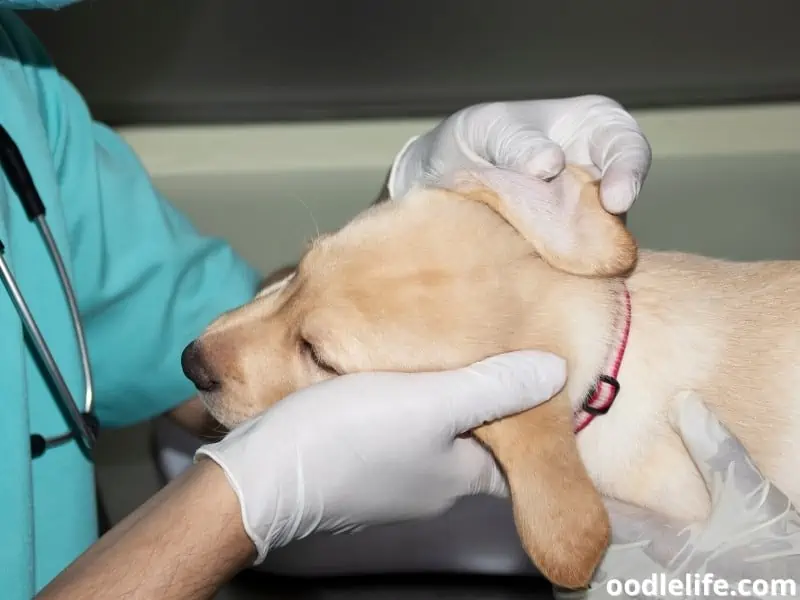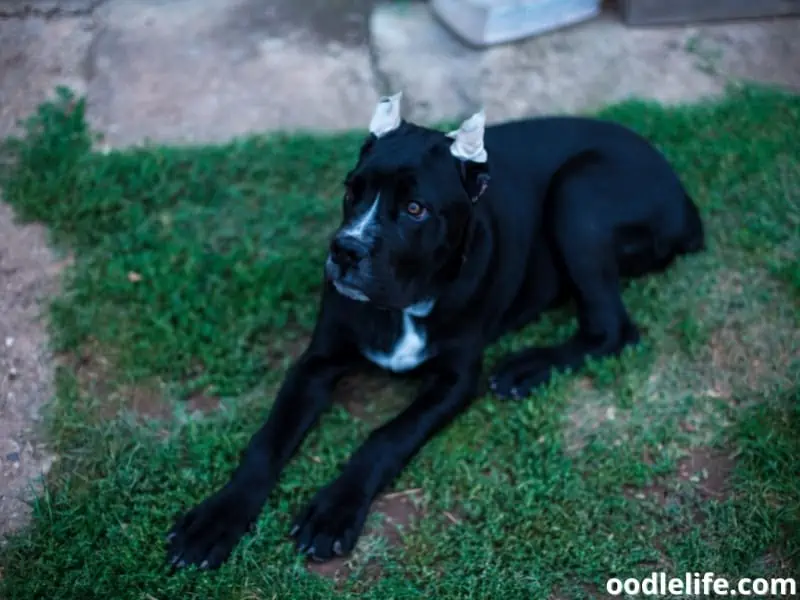How to Tell If A Dog’s Ears Will Stand Up? (When Do Puppy Ears Stand Up)
While purebred dogs have genetic predispositions and more standard appearances, mixed breed puppies sometimes look nothing like themselves as puppies when they reach adulthood!
In addition, littermates can look completely different, and without knowing, it would be impossible to guess that a black, floppy-eared pooch could be the sibling of a white, perky-eared one.

Purebred dogs have something called a breed standard defined by the American Kennel Club and other governing organizations worldwide. Mixed breeds, however, can look like either one of their parent breeds, or completely different!
All puppies are born with cute floppy ears that fall in front of their heads, but as they grow, their cartilage might harden to make the ear perk straight from their heads, giving them a wolf-like appearance like a Husky or a German Shepherd.
If you were wondering whether your puppy’s ears will stand, this blog post is for you. We’ll look at the process of floppy ears turning into perky ones and the pros and cons of each.
When Do A Dog’s Ears Typically Stand?
A dog’s ears standing is a relatively slow process that develops over time. It typically starts about two to three weeks after birth and can take up to seven or eight months to stand completely upright. This depends significantly on the dog’s size and when it reaches its full adult height.
Smaller dogs attain their full height quicker and might have perky ears sooner, while larger breeds tend to take their time growing and might have upright ears later.
Ears rarely stand all at once, but instead, will stand and flop periodically until it finally remains upright and retains the wolf-like shape.

What Affects The Ears’ Standing?
You might notice that after your dog’s ears stand, they come right back down and end up flopping again. This is a very natural thing that happens when your dog starts teething.
Standing ears are made of cartilage, and cartilage is made from calcium. When a puppy is growing their adult teeth, all the calcium in their body is diverted towards the teeth, which might leave the ears a little floppy. However, it might go back up once the puppy finishes teething after a few months.

How Can You Tell If A Dog’s Ears Will Stand?
More often than not, the most significant indicator of whether your dog’s ears will stand depends on their breed, and the appearance of two of their parents if they are a mix.
1. What Breed Is The Dog?
The first indicator of whether or not your dog’s ear will stand is your dog’s breed. Breeds with super floppy ears include the Cocker Spaniel, Beagle, and some Hounds, while breeds with upright ears include German Shepherds, Akitas, Huskies, Chihuahuas, and Yorkshire Terriers.
You can look at the breed standard under “ears” for a more thorough explanation of what a breed’s ears are supposed to look like.
If your dog is a mixed breed, both parent breeds must have standing ears for it to have the same. However, mixed breeds in general have unexpected genetic traits, so don’t bet on it.
In addition, different breeds will have upright ears at different times. For example, a German Shepherd’s ears start to stand at five weeks and might be fully erect at 20 weeks. Siberian Huskies can take from 6 to 10 weeks, while Chihuahuas can start at 6 weeks and take as much as 5 to 6 months.

2. How Does Your Dog Get Excited?
Another indicator is your dog’s expression of excitement. Dogs have their own way of communication, like wagging their tails to show excitement or bending their tails inwards to show fear. Likewise, their ears are a profound communicator in a dog’s body language.
Dogs that constantly perk their ears when they hear something strange or their name might be more adept at expressing their emotions through their ears, and this might help their ears stand naturally.

3. How Is The Dog’s Ear Position?
Also, the head anatomy will serve as an indicator. If your dog’s ears are positioned near to each other and high above their heads then they will probably stand tall. Also, smaller ears relative to the dog’s size tend to stand erect faster than bigger ears.

Should You Be Worried If Your Dog’s Ears Don’t Stand?
You shouldn’t be worried if your dog’s ears don’t stand unless you want to show him in conformation shows and he doesn’t meet the breed standards. Another instance that you might want standing ears is if your dog is a hunting dog and floppy ears can be a target.
If you want to be sure, if your dog’s ears show no signs of coming up after about six to eight months, you can check with your vet to make sure there isn’t an underlying health condition, or that your dog isn’t suffering from a lack of nutrition.
Some argue that floppy ears have a bigger chance of ear infection because they stay down all the time, blocking air circulation and serving as a more fertile, moist environment for bacteria to accumulate.
However, this problem can be prevented by cleaning the ears regularly which you are probably doing anyway as part of your dog’s grooming routine.

Is There Anything I Can Do To Make My Dog’s Ears Stand?
There are natural ways that you can try to make your dog’s ears stand, and also some surgical ways that tend to be controversial and a subject of never-ending, heated debate.
Natural Ways
1. Chew!
One of the best things you can do to accelerate the standing process is to make your dog chew more. Yep, chew!
Just like any part of the body, the ears need muscles to move. And a dog’s standing ears depend wholly on a group of muscles in the neck that helps them jerk their ears up effortlessly. Luckily, strengthening these muscles is done by a very simple trick, which is chewing.
Chewing strengthens the head and jaw muscles, so giving your dog a chew toy freely or some dental sticks will help it not only to stay entertained but also strengthen its muscles and hopefully make its ears stand faster.

2. Watch The Diet
As we mentioned briefly, erect ears are closely related to diet because they depend on cartilage. Just like you can adjust the diet to give more nutrients that strengthen the bones, you can do the same for cartilage.
Therefore, along with your vet, make sure your puppy is taking enough nutrients, especially proteins. Some say that you can put calcium supplements into the diet but it is not recommended. Some also recommend giving vitamin C supplements, but whatever you do, check with your vet on the proper way to supplement.

3. Tapping
Some people use this method to help the ears stay erect or to help them make a perfect shape.
It is putting a piece of paper, foam, or material suitable for dogs as a brace inside the ear.
You simply cut the shape of your dog’s ear out on a material that won’t irritate your dog. Make it large enough to hold the ear and small enough not to irritate them or get stuck in the ear canal.
Stick this brace inside the dog’s ear with safe, human-grade adhesive tape or preferably with child-safe or pet-safe glue. You can leave it there for a week and then get them out to give the ear a chance to breathe, clean the ears, and repeat the process.
Just be sure to constantly check on your dog’s ears and make sure that he or she is completely comfortable.

Surgical Method
Ear Cropping
One of the most controversial practices like tail docking, ear cropping is considered illegal in European countries, UK, and Australia.
Ear cropping is basically cutting part of the dog’s ear for them to look erect. This surgery is typically done on puppies by a veterinary professional at birth or a few days old. Many breeds like the Doberman have their ears cropped and tail docked when they are mere days old.
Some advocates of this practice argue that it prepares dogs for the field, like hunting dogs that might get their floppy ears hurt by defensive prey. Others argue that ear cropping is part of the breed standard for certain breeds.
There are several health risks associated with ear cropping, like infection, bleeding, and loss of hearing. Some dogs undergo this procedure when they are days old, often without anesthesia.
Healing might take up to 6 months for the dog. During this period they must be carefully attended to and have their bandages changed and the wound monitored.
The argument against and for traditional practices like ear cropping and tail docking continues to rage on and will likely continue as long as there are advocates on both sides.

Final Thoughts
The shape of a dog’s ears is largely determined by genetics, and even puppies from the same litter can have different results. Some dogs with droopy ears will eventually have them stand up on their own as they grow older, while others will always have floppy ears.
Ultimately, the best way to determine if a dog’s ears will stand is to wait and see. With a little patience, you’ll eventually end up with the perfect dog for you, regardless of ear shape!